Enzymatic Synthesis and Characterization of a Novel α-1→6-Glucosyl Rebaudioside C Derivative Sweetener
Abstract
:1. Introduction
2. Materials and Methods
2.1. Experimental Sections
2.1.1. Enzyme Modification Process
2.1.2. Removal of Citric Acid Buffer, Residual Sugars and Deactivated Residual Enzyme
2.1.3. Isolation and Purification of the reb C+1G Compound
2.1.4. Liquid Chromatography-Ultra Violet/Mass Spectrometry Analysis
2.1.5. MS Product Ion Scan
2.1.6. Nuclear Magnetic Resonance Spectroscopy (NMR)
2.1.7. Sensory Evaluation
3. Results and Discussion
3.1. Preliminary Structure Determination by Liquid Chromatography-Mass Spectrometry
3.2. Nuclear Magnetic Resonance Structure Elucidation
3.3. Sensory Evaluation
4. Conclusions
Supplementary Materials
Author Contributions
Funding
Acknowledgments
Conflicts of Interest
References
- Available online: https://www.foodnavigator-usa.com/Article/2018/10/01/US-retail-sales-of-stevia-sweeteners-rose-11.9-in-the-past-year-as-sales-of-artificial-sweeteners-continue-to-slide (accessed on 10 November 2018).
- Prakash, I.; Markosyan, A.; Bunders, C. Development of Next Generation Stevia Sweetener: Rebaudioside M. Foods 2015, 3, 162–175. [Google Scholar] [CrossRef] [PubMed]
- Olsson, K.; Carlsen, S.; Semmler, A.; Simón, E.; Mikkelsen, M.D.; Møller, B.L. Microbial production of next-generation stevia sweeteners. Microb. Cell Fact. 2016, 15, 1–14. [Google Scholar] [CrossRef] [PubMed]
- Prakash, I.; Bunders, C.; Devkota, K.P.; Charan, R.D.; Ramirez, C.; Priedemann, C.; Markosyan, A. Isolation and Characterization of a Novel Rebaudioside M Isomer from a Bioconversion Reaction of Rebaudioside A and NMR Comparison Studies of Rebaudioside M Isolated from Stevia rebaudiana Bertoni and Stevia rebaudiana Morita. Biomolecules 2014, 4, 374–389. [Google Scholar] [CrossRef] [PubMed]
- Adari, B.R.; Alavala, S.; George, S.A.; Meshram, H.M.; Tiwari, A.K.; Akella, V.S.; Sarma, S. Synthesis of rebaudioside-A by enzymatic transglycosylation of stevioside present in the leaves of Stevia rebaudiana Bertoni. Food Chem. 2016, 200, 154–158. [Google Scholar] [CrossRef] [PubMed]
- Kochikyan, V.T.; Markosyan, A.A.; Abelyan, L.A. Combined enzymatic modification of stevioside and rebaudioside A. Appl. Biochem. Microbiol. 2006, 42, 31–37. [Google Scholar] [CrossRef]
- Gerwig, G.J.; te Poele, E.M.; Dijkhuizen, L.; Kamerling, J.P. Chapter One—Stevia Glycosides: Chemical and Enzymatic Modifications of Their Carbohydrate Moieties to Improve the Sweet-Tasting Quality. Adv. Carbohydr. Chem. Biochem. 2016, 73, 1–72. [Google Scholar] [PubMed]
- Tanaka, O. Improvement of taste of natural sweeteners. Pure Appl. Chem. 1997, 69, 675–684. [Google Scholar] [CrossRef]
- Available online: https://www.foodnavigator-usa.com/Article/2018/03/20/Cargill-launches-EverSweet-fermented-steviol-glycosides (accessed on 11 December 2018).
- Uhler, B.; Yang, Z. Rebaudioside A and other unreported steviol glycoside isomers found in the sweet tea leaf. Phytochem. Lett. 2018, 28, 93–97. [Google Scholar] [CrossRef]
- FDA GRAS Notice, GRN No. 662. 7 November 2017. Available online: http://www.fda.gov/Food/IngredientsPackagingLabeling/GRAS/NoticeInventory/default.htm (accessed on 11 December 2018).
- Cargill, Inc. FDA CFSAN/Office of food additive safety agency response letter to Cargill, Inc. regarding Notification of GRAS determination for sucromalt. Gras Notice No 000258; 8 September 2008. [Google Scholar]
- Abelyan, V.A.; Balayan, A.M.; Ghochikyan, V.T.; Markosyan, A.A. Transglycosylation of stevioside by cyclodextrin glucanotransferases of various groups of microorganisms. Appl. Biochem. Microbiol. 2004, 40, 129–134. [Google Scholar] [CrossRef]
- Koyama, E.; Kitazawa, K.; Ohori, Y.; Izawa, O.; Kakegawa, K.; Fujino, A.; Ui, M. In vitro metabolism of the glycosidic sweeteners, stevia mixture and enzymatically modified stevia in human intestinal microflora. Food Chem. Toxicol. 2003, 41, 359–374. [Google Scholar] [CrossRef]
- Te Poele, E.M.; Devlamynck, T.; Jäger, M.; Gerwig, J.G.; van de Walle, D.; Dewettinck, K.; Hirsch, K.H.A.; Kamerling, P.J.; Soetaert, W.; Dijkhuizen, L. Glucansucrase (mutant) enzymes from Lactobacillus reuteri 180 efficiently transglucosylate Stevia component rebaudioside A, resulting in a superior taste. Sci. Rep. 2018, 8, 1516. [Google Scholar] [CrossRef] [PubMed]
- Perera, W.H.; Avula, B.; Khan, I.A.; McChesney, J. Assignment of sugar arrangement in branched steviol glycosides using electrospray ionization quadrupole time-of-flight tandem mass spectrometry. Rapid Commun. Mass Spectrom. 2017, 31, 315–324. [Google Scholar] [CrossRef] [PubMed]

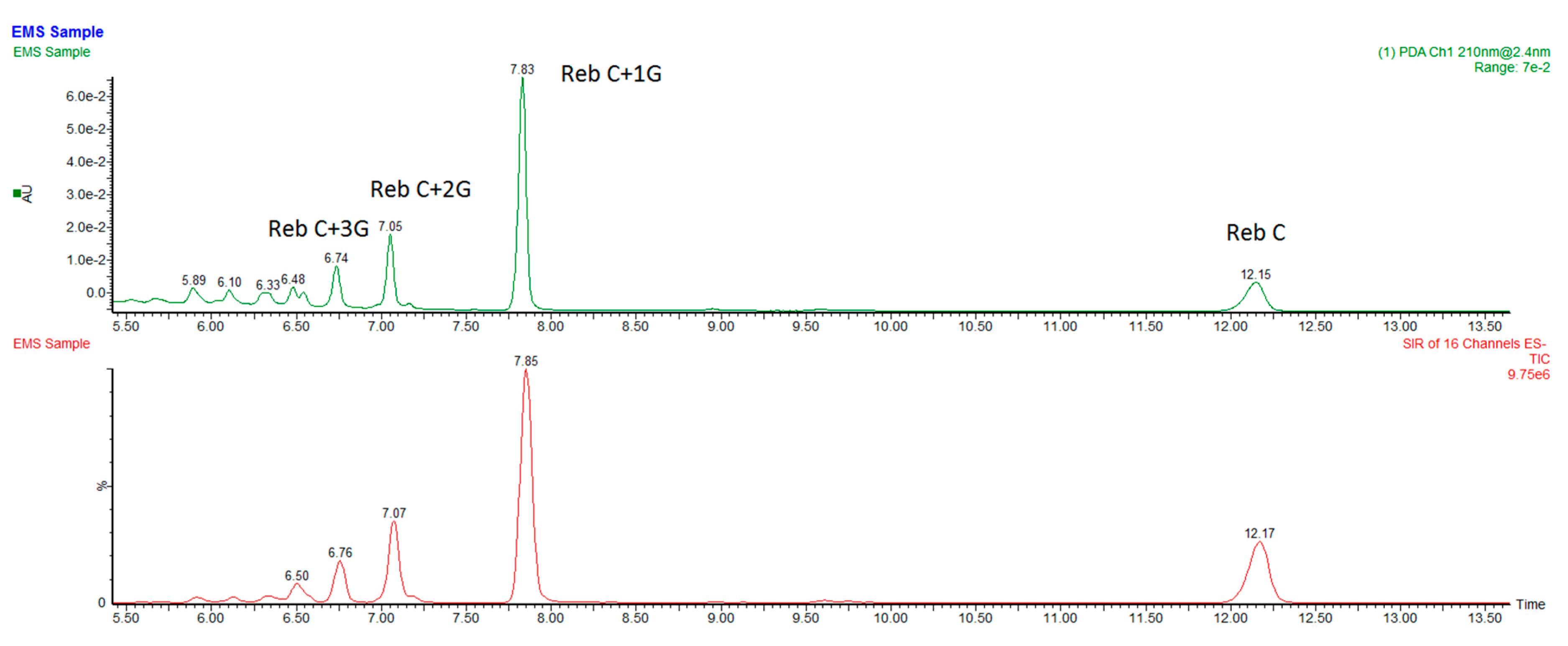
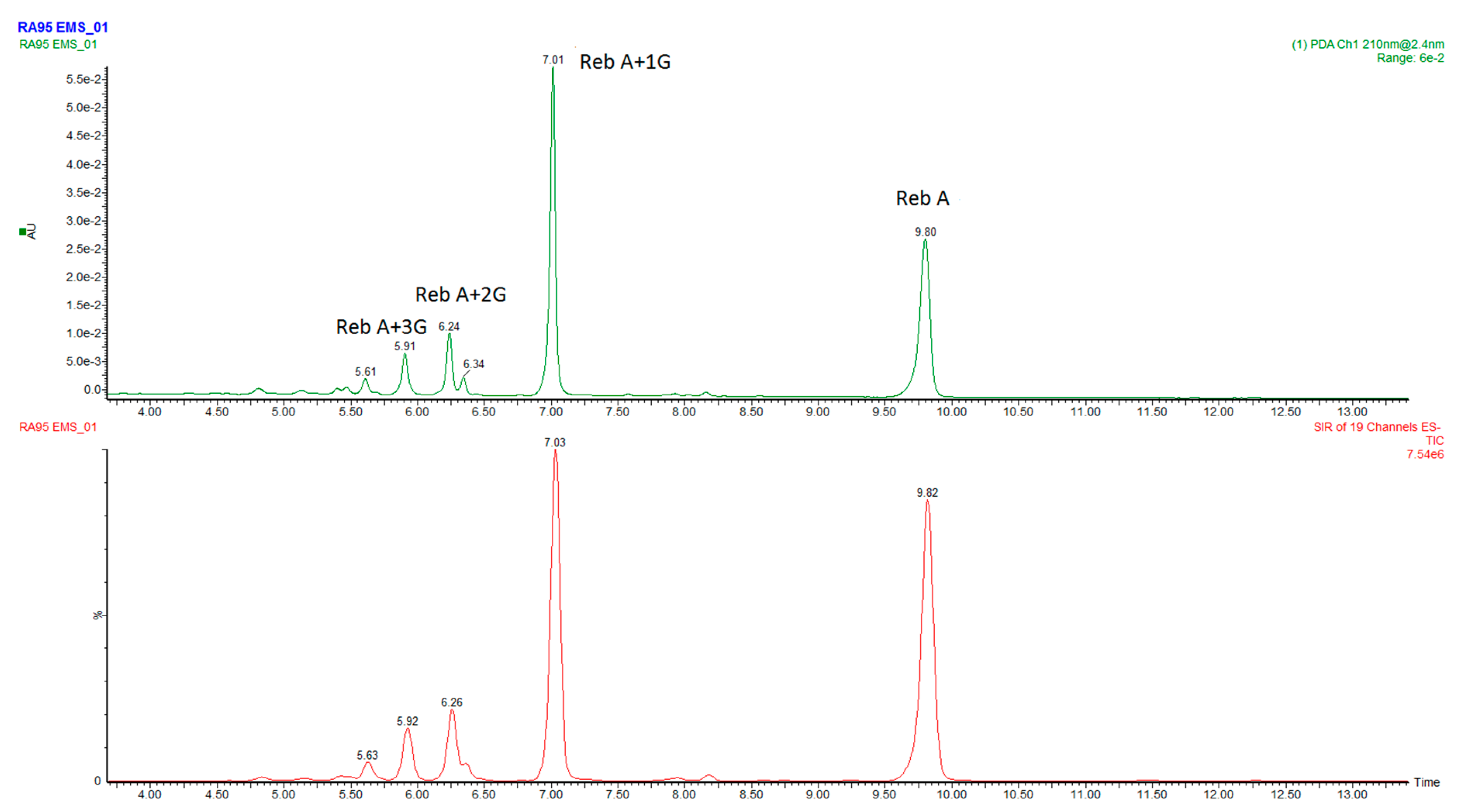
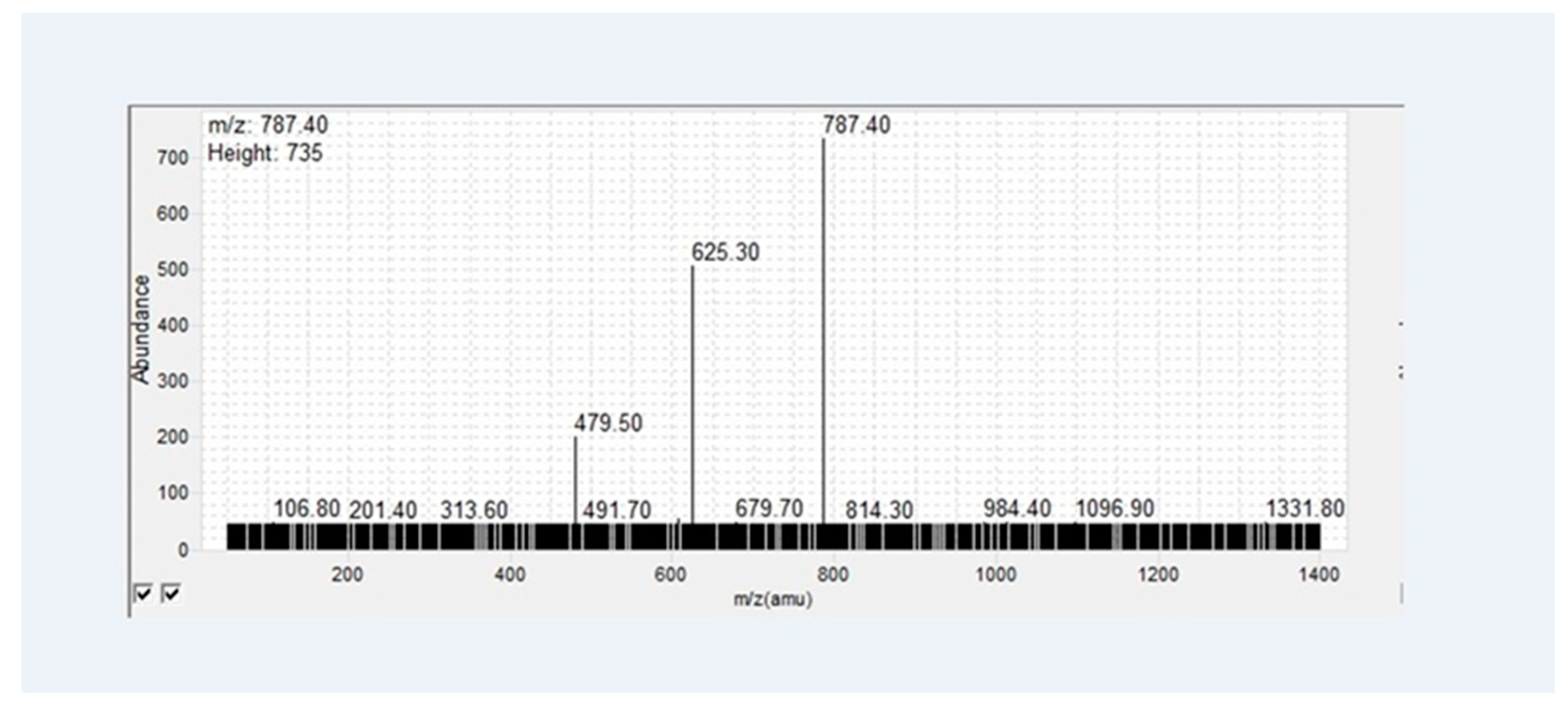
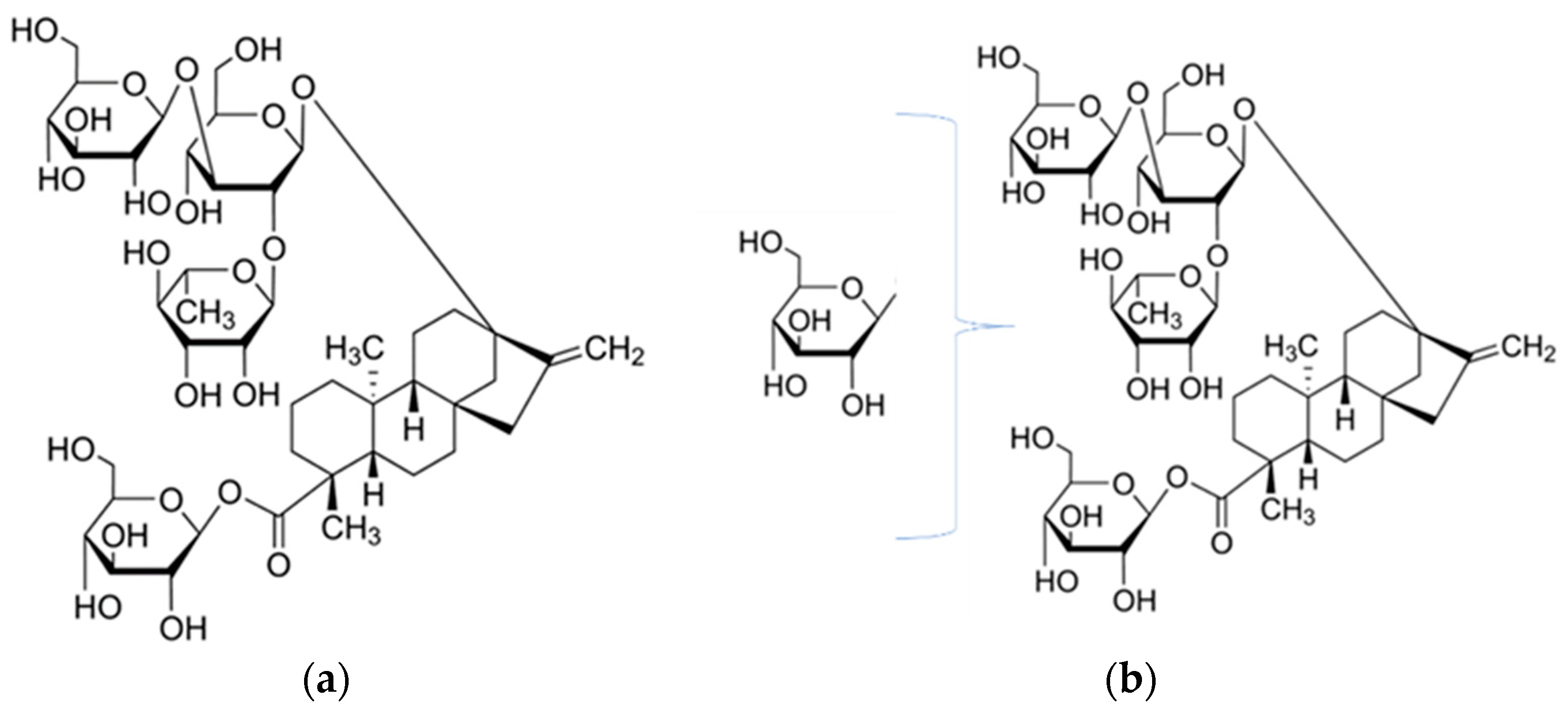
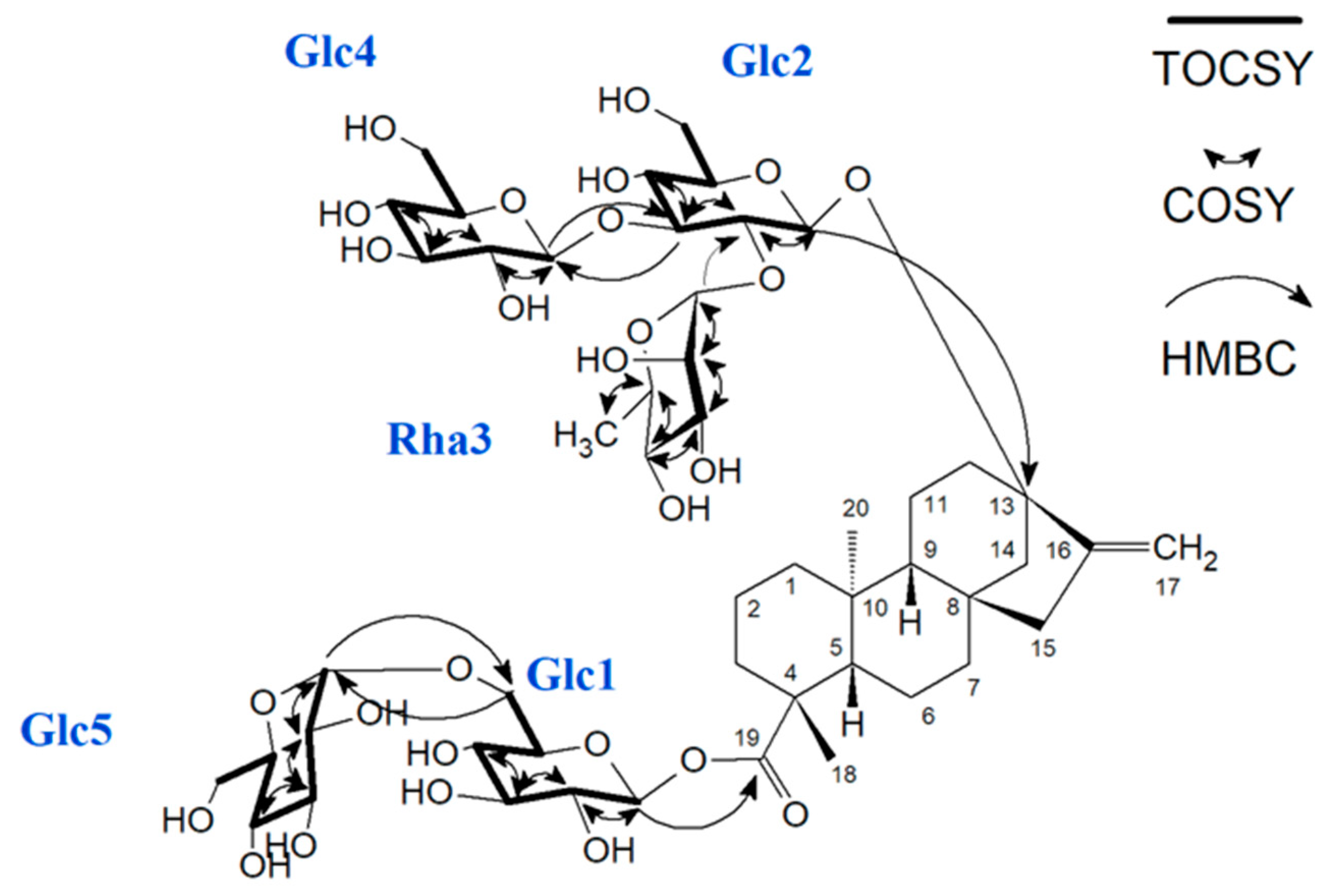
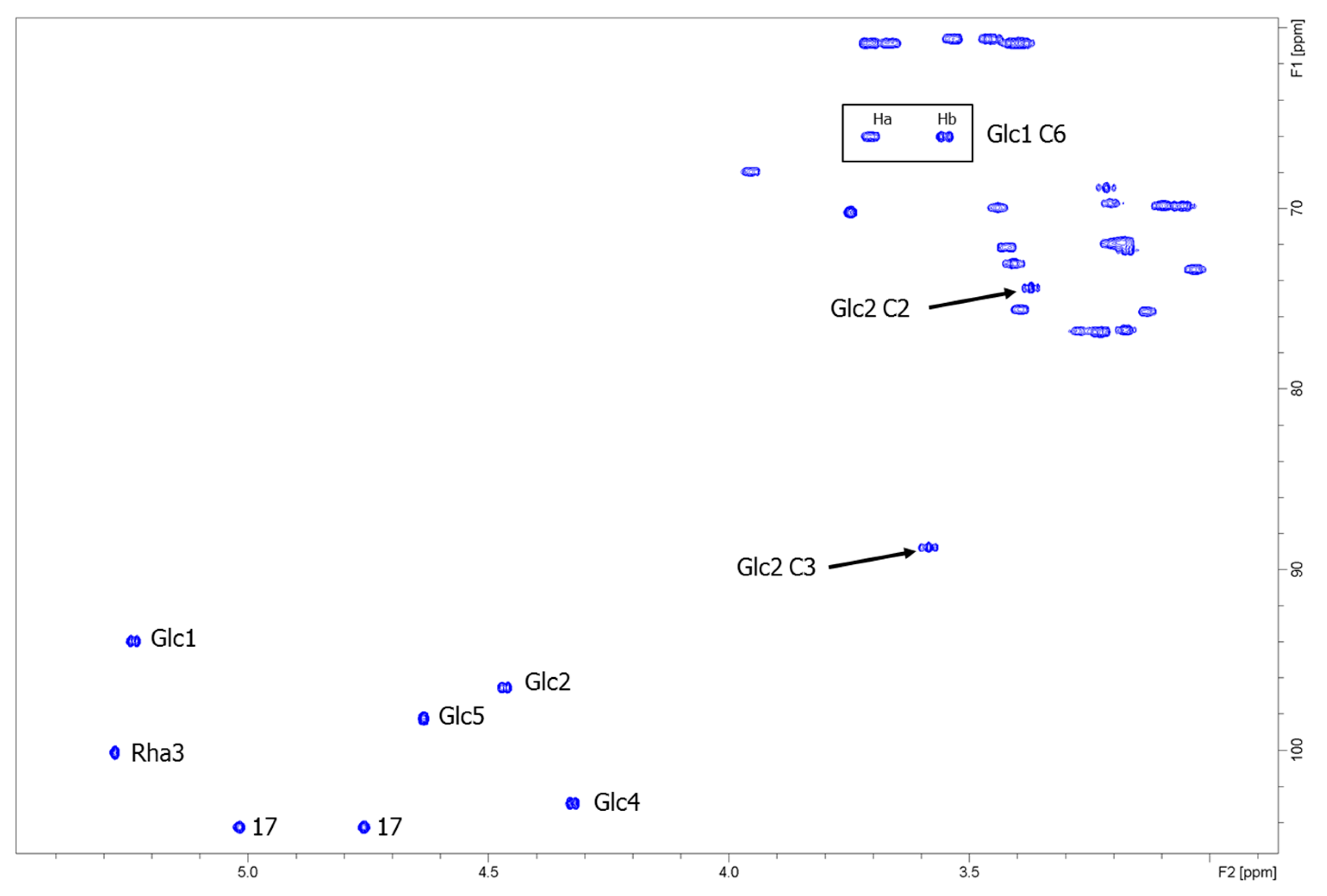
| 1H Chemical Shift δ (ppm) | 13C Chemical Shift δ (ppm) | Multiplicity | Number H | Assignment |
|---|---|---|---|---|
| Steviol | ||||
| 0.77, 1.78 | 40.0 a | multiplet | 2 | H-atoms at C-1 |
| 1.35, 1.79 | 18.6 | multiplet | 2 | H-atoms at C-2 |
| 0.96, 2.05 | 37.4 | multiplet | 2 | H-atoms at C-3 |
| -- | 43.1 | -- | -- | C-4 |
| 1.04 | 56.4 | multiplet | 1 | H-atom at C-5 |
| 1.70, 1.98 | 21.1 | multiplet | 2 | H-atoms at C-6 |
| 1.34, 1.48 | 41.0 | multiplet | 2 | H-atoms at C-7 |
| -- | 41.7 | -- | -- | C-8 |
| 0.91 | 53.1 | multiplet | 1 | H-atom at C-9 |
| -- | 38.9 a | -- | -- | C-10 |
| 1.50, 1.68 | 20.0 | multiplet | 2 | H-atoms at C-11 |
| 1.44, 1.84 | 36.7 | multiplet | 2 | H-atoms at C-12 |
| -- | 85.5 | -- | -- | C-13 |
| 1.58, 2.02 | 42.3 | multiplet | 2 | H-atoms at C-14 |
| 1.97, 2.07 | 47.5 | multiplet | 2 | H-atoms at C-15 |
| -- | 152.7 | -- | -- | C-16 |
| 4.76, 5.02 | 104.3 | multiplet | 2 | H-atoms at C-17 |
| 1.13 | 27.8 | singlet | 3 | H-atoms at C-18 |
| -- | 175.7 | -- | -- | C-19 |
| 0.86 | 14.9 | singlet | 3 | H-atoms at C-20 |
| Glc1 | ||||
| 5.24 | 93.9 | doublet, 8.2 Hz | 1 | H-atom at C-1 |
| 3.17 b | 72.3 b | 1 | H-atom at C-2 | |
| 3.27 | 76.8 | 1 | H-atom at C-3 | |
| 3.21 | 69.7 | 1 | H-atom at C-4 | |
| 3.40 | 75.6 | 1 | H-atom at C-5 | |
| 3.55, 3.70 | 66.0 | 2 | H-atoms at C-6 | |
| Glc2 | ||||
| 4.46 | 96.5 | doublet, 7.8 Hz | 1 | H-atom at C-1 |
| 3.37 | 74.4 | 1 | H-atom at C-2 | |
| 3.58 | 88.7 | 1 | H-atom at C-3 | |
| 3.21 | 68.8 | 1 | H-atom at C-4 | |
| 3.13 | 75.7 | 1 | H-atom at C-5 | |
| 3.40 c, 3.65 | 60.9 c | 2 | H-atoms at C-6 | |
| Rha3 | ||||
| 5.28 | 100.1 | doublet, ~1 Hz | 1 | H-atom at C-1 |
| 3.75 | 70.2 | 1 | H-atom at C-2 | |
| 3.44 | 69.9 | 1 | H-atom at C-3 | |
| 3.18 b | 72.2 b | 1 | H-atom at C-4 | |
| 3.95 | 67.9 | 1 | H-atom at C-5 | |
| 1.07 | 18.1 | 3 | H-atoms at C-6 | |
| Glc4 | ||||
| 4.32 | 102.9 | doublet, 7.9 Hz | 1 | H-atom at C-1 |
| 3.03 | 73.5 | 1 | H-atom at C-2 | |
| 3.17 | 76.7 | 1 | H-atom at C-3 | |
| 3.05 | 69.9 | 1 | H-atom at C-4 | |
| 3.23 | 77.0 | 1 | H-atom at C-5 | |
| 3.40 c, 3.71 | 60.9 c | 2 | H-atoms at C-6 | |
| Glc5 | ||||
| 4.64 | 98.2 | doublet, ~1 Hz | 1 | H-atom at C-1 |
| 3.18 b | 71.9 b | 1 | H-atom at C-2 | |
| 3.41 | 73.0 | 1 | H-atom at C-3 | |
| 3.10 | 69.9 | 1 | H-atom at C-4 | |
| 3.42 | 72.1 | 1 | H-atom at C-5 | |
| 3.46, 3.53 | 60.7 | 2 | H-atoms at C-6 |
© 2019 by the authors. Licensee MDPI, Basel, Switzerland. This article is an open access article distributed under the terms and conditions of the Creative Commons Attribution (CC BY) license (http://creativecommons.org/licenses/by/4.0/).
Share and Cite
Yang, Z.; Uhler, B.; Zheng, T.; Adams, K.M. Enzymatic Synthesis and Characterization of a Novel α-1→6-Glucosyl Rebaudioside C Derivative Sweetener. Biomolecules 2019, 9, 27. https://doi.org/10.3390/biom9010027
Yang Z, Uhler B, Zheng T, Adams KM. Enzymatic Synthesis and Characterization of a Novel α-1→6-Glucosyl Rebaudioside C Derivative Sweetener. Biomolecules. 2019; 9(1):27. https://doi.org/10.3390/biom9010027
Chicago/Turabian StyleYang, Zheng, Brandon Uhler, Ted Zheng, and Kristie M. Adams. 2019. "Enzymatic Synthesis and Characterization of a Novel α-1→6-Glucosyl Rebaudioside C Derivative Sweetener" Biomolecules 9, no. 1: 27. https://doi.org/10.3390/biom9010027





